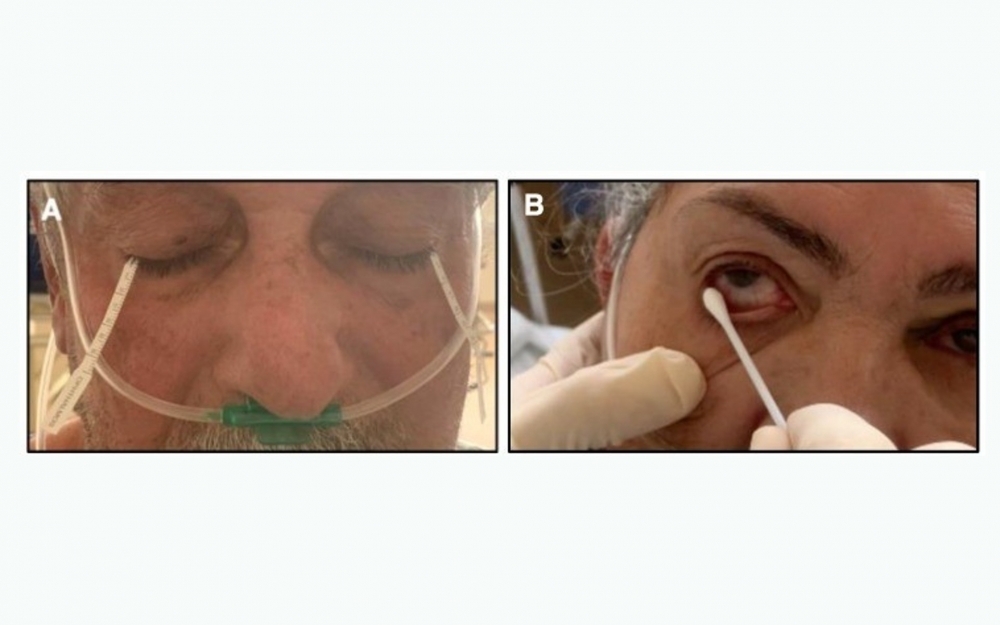


The scientists collected samples by conjunctival swab (left) and Schirmer strip, normally used to determine whether the eye produces enough tears (photo: Luiz Fernando Manzoni Lourençone/USP)
Published on 01/31/2023
By Luciana Constantino | Agência FAPESP – Research led by scientists at the University of São Paulo (USP) in Brazil has found that the coronavirus that causes COVID-19 can be detected in tears collected by swabbing. A swab is an absorbent cotton pad on a flexible rod used to clean wounds, apply medication and take specimens.
The researchers analyzed samples from patients diagnosed with the disease by conventional methods and admitted to the Hospital for Rehabilitation of Craniofacial Anomalies (HRAC) run by the Bauru Dental School (FOB-USP). SARS-CoV-2 was detected in 18.2% of the samples, suggesting this method could be an alternative to nasopharyngeal swabbing, which is unpleasant, and that health workers should take steps to protect themselves against infection via patients’ tears, although the risk is admittedly low.
Moreover, a combination of two factors – more comorbidities and a higher mortality rate – among patients whose tear samples tested positive suggests that this method of detection of the virus could be a prognosis predictor.
The study is reported in an article published in the November 2022 issue of the Journal of Clinical Medicine.
“Initially, we set out to develop a diagnostic test based on easier collection of material without causing patient discomfort. Nasal and nasopharyngeal swabbing is not only unpleasant but also often performed incorrectly. For people with a nasal septum deviation, it can be a problem. We took the view that tear sampling would be easy to execute and more tolerable. We succeeded in showing this to be feasible. Among the limitations of the study was not knowing whether the amount of liquid collected for the test influences its result,” Luiz Fernando Manzoni Lourençone, professor of medicine at HRAC and last author of the article, told Agência FAPESP.
The findings suggest that the probability of detecting the virus in tears is greater when the patient has a high viral load, which can lead to viremia in body fluids, he added.
The study was supported by FAPESP via a scientific initiation scholarship awarded to Luís Expedito Sabage, an undergraduate student supervised by Lourençone.
Technique
The study cohort comprised 61 hospitalized patients, with 28 testing negative and 33 positive for COVID-19 by RT-qPCR via nasopharyngeal swab. Tears were analyzed from all 33 positives and from 14 of the 28 negatives. The tears were collected in the first half of 2021 when the main viral variants circulating in São Paulo state were gamma and delta.
In addition to collection by conjunctival swab, the scientists also used a technique known as the Schirmer strip test, in which a strip of filter paper is placed for five minutes inside the lower eyelid (normally used to determine whether the eye produces enough tears). The samples were analyzed between July and November 2021.
SARS-CoV-2 was detected in 18.2% of the samples collected by conjunctival swab and 12.1% of those collected by Schirmer strip. As expected, none of the patients who tested negative for the virus via nasopharyngeal swab had tears that tested positive.
The Charlson Comorbidity Index (CCI) was used to predict risk of death within a year of hospitalization for patients with 20 specific conditions. Patients with SARS-CoV-2 particles in tear samples had an almost sevenfold chance of dying compared to patients with a negative result. Those patients also had other factors that could contribute to death, such as a poor ten-year survival rate based on CCI.
Most of the patients had low tear production and eye discomfort regardless of their COVID-19 diagnosis, possibly pointing to the need for artificial tear use during hospitalization, according to the authors.
The study also included demographic, clinical and ocular symptom data. The main diagnostic test used was real-time quantitative PCR (polymerase chain reaction), which can detect a single copy of viral RNA in a sample and is considered the gold standard for diagnosing COVID-19 by clinical analysis laboratories around the world.
Innovating in comparison with previous research, in this study viral RNA positivity was determined much more precisely by analyzing the nucleocapsid (N), envelope (E) and RNA-dependent RNA polymerase (RdRp).
An article published in July 2021 in Experimental Biology and Medicine by a group of researchers at the State University of Campinas’s School of Medical Sciences (FCM-UNICAMP), also in São Paulo state, reported the results of a study conducted at its teaching hospital where SARS-CoV-2 was detected in tear samples from 8.43% of the 83 patients enrolled in the study.
“When we started, in early 2021, we lacked the technology to cross-reference certain types of data as a route out of basic science and into clinical practice. Since then, Sabage has worked as a research intern at Stanford University’s Byers Eye Institute [in the United States], a leading center for advanced studies of ocular fluids. Their technology enabled us to detect several correlations and confirm the presence of SARS-CoV-2 in our tear samples. Partnering with another team brought results for our campus and opened up a new research line,” Lourençone said.
The internship at Stanford was supported by FAPESP.
Possibilities
The research group has now begun working on a new line that focuses on detecting other viral diseases by means of tests and analyses relating to the eyes. “Many viruses haven’t been studied sufficiently in Brazil. We want to develop solutions that improve the quality of life for patients. We plan to analyze other viral conditions that become systemic,” he said.
The article “Conjunctival swabs reveal higher detection rate compared to Schirmer strips for SARS-CoV-2 RNA detection in tears of hospitalized COVID-19 patients” is at: www.mdpi.com/2077-0383/11/23/6929.
Source: https://agencia.fapesp.br/40589